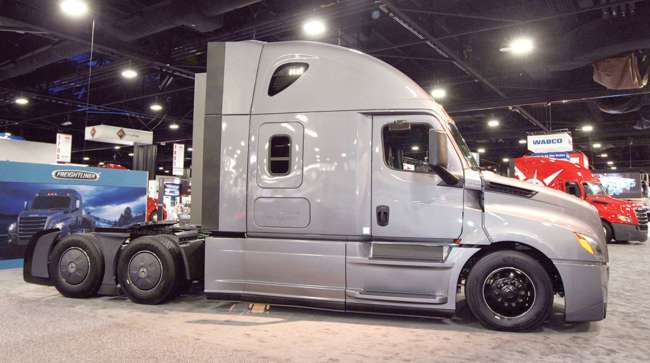Staff Reporter
Class 8 Sales Fall for Fifth Consecutive Month in December

[Stay on top of transportation news: Get TTNews in your inbox.]
Class 8 retail truck sales in December fell year-over-year for a fifth consecutive month, Wards Intelligence data showed, but full-year 2023 sales ended 4.9% higher compared with the prior year.
Sales fell 19.8% to 23,390 units in December from 29,172 trucks in the same month in 2022 but rose 22.9% sequentially from 19,027 units sold in November.
“It is not a [monthly] bad number, if you look at what’s going on with the ongoing decline in year-over-year comparisons,” ACT Research Vice President Steve Tam told Transport Topics in an interview Jan. 15.
December was expected to see an increase in sales compared with November. “On a percentage basis, it did exactly what it was expected to compared with November. The problem was, of course, the base point was low,” Tam said.

Tam
While full-year sales ended 2023 at 266,752, some 4.9% above 2022’s total, the lead over the previous year shrank in the final month of the year from 8% through November.
ACT expected full-year sales of around 273,000 after trimming its forecast because of November’s figures, said Tam.
Sales in December decreased for six of the seven major truck makers year-over-year, Wards data show.
Daimler Truck North America’s Western Star was the one exception, seeing a 19% increase in sales to 909 units from 764.
Sister DTNA brand Freightliner won the largest market share at 33%, but sales declined 27.6% to 7,718 units from 10,660 trucks in December 2022.
Ben Gardiner, a cybersecurity expert at the National Motor Freight Traffic Association, shares practical, effective strategies to shield your business. He offers insights into operating systems and a comprehensive guide to cyber resilience. Tune in above or by going to RoadSigns.ttnews.com.
“Demand for trucks remained strong, and overall, we had another solid month in December, despite the challenging supply chain situation we and our entire industry continue to face,” David Carson, DTNA senior vice president of sales and marketing, said in an email.
“We are particularly pleased with continued success and increased demand for the new X Series Western Star trucks, which are taking the brand to new heights,” he added.
For the full year, Daimler Truck North America sales across all classes and units rose 4% year-over-year to 195,014 units from 186,779 vehicles a year earlier, parent company Daimler Truck AG said Jan. 15.
Freightliner and Western Star sales in 2023 totaled 156,733, according to Wards data.
Class 8 sales at Kenworth, which snagged the second-largest market share in December at 17.6%, decreased 9.3% to 4,105 from 4,528. Fellow Paccar unit Peterbilt’s sales fell 16.1% to 3,881 from 4,624.
Volvo Trucks North America’s sales fell 4.3% year-over-year to 2,478 units from 2,590, according to Wards.

Koeck
“The industry [retail sales] came in as expected, but you can tell the market is softening now,” Magnus Koeck, vice president of strategy, marketing and brand management at Volvo Trucks North America, told TT.
“Even if the supply chain constraints have improved, we are still not where we want to be, and that is a contributing factor in the lower retail numbers for us. We ended up at 10.6% in the U.S. for December isolated and 10% for the full year. In Canada, we were down for the full year and ended up at 11.8%,” said Koeck.
Mack Trucks’ sales decreased 24.4% to 1,842 from 2,436. Both Mack and VTNA are Volvo Group brands.
Jonathan Randall, president of Mack Trucks North America, said in a Jan. 17 email that fleet capacity continues to exceed freight demand.
“This imbalance has been seen in past market cycles and has resulted in lower freight pricing in 2023. If the trend continues, lower rates will influence capacity to exit the market and supply and demand levels will be better balanced,” said Randall, adding: “Couple that with limited dealer inventory due to continued supply disruptions and we experienced a year-over-year drop in retail sales.”
Tam agreed. “There’s a bigger message going back to carriers seeing their profits fall in the third quarter,” he said, noting net profit margins of around 4%. “A year earlier, net profit margins were around 7%, so they’ve seen a pretty good haircut.”
“The next six months will have a meaningful and tangible input on their appetite for trucks,” he said.

Vieth
As a result, there is a risk of a Class 8 inventory surge in the first quarter of 2024, said ACT President Kenny Vieth in the forecasting and analysis group’s latest commercial vehicle outlook, released Jan. 11, particularly with January and February typically the worst months for retail sales.
“Something we marveled at, as late as this September, was the close correlation between build and sales that had kept Class 8 inventory levels, both nominal and relative, near perfectly positioned very late into the cycle,” said Vieth.
“Increasingly, with inventories already rising and the sales calendar becoming unfriendly in early 2024, the data suggest this cycle will not provide an ‘it’s different this time’ outcome, with more inventory accrued in the last two months than the preceding 12 months,” he said.
Even OEMs’ Class 8 optimism is waning. “We still expect the market to be relatively strong in 2024, but we will see a shift in the customer and product mix, knowing the longhaul sleeper market is declining more than the regional-haul and vocational segments,” Koeck told TT.
Want more news? Listen to today's daily briefing below or go here for more info:





